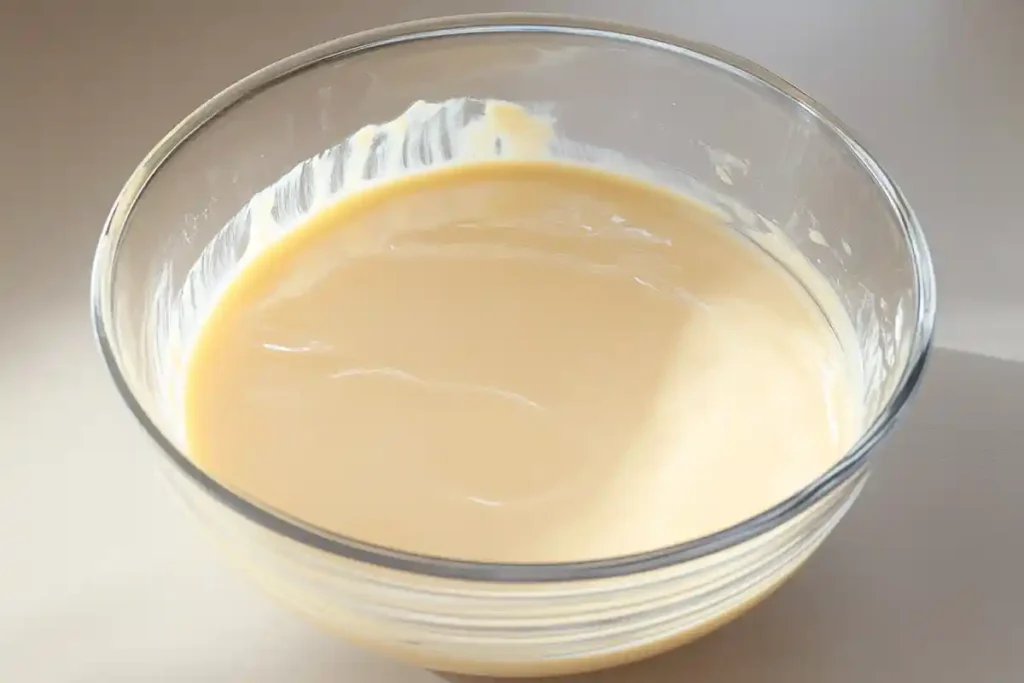Crepes are one of those versatile dishes that can swing effortlessly between sweet indulgence and savory satisfaction. But what if I told you that you could make them even more special using something most people throw away? Yes, I’m talking about sourdough discard! This often-overlooked byproduct of sourdough baking is not just a waste product—it’s a culinary treasure waiting to be discovered.
This guide will explore the art of creating sourdough discard crepes, step-by-step methods, essential tips, and creative serving ideas. Plus, we’ll address common questions like, “What should I do with my sourdough discard?” and “Can I use sourdough discard instead of buttermilk?”
So, if you’re ready to transform your discard into a delicious crepe masterpiece, let’s dive right in!
Table of Contents
Understanding Sourdough Discard Crepes and Its Culinary Uses
What Is Sourdough Discard?
Definition and Characteristics
Sourdough discard refers to the portion of the sourdough starter that is removed before feeding it with fresh flour and water. It’s typically tangy, slightly acidic, and has a subtle fermented aroma. Although it’s called “discard,” it’s far from useless. Its rich flavor profile can add depth to many recipes, especially crepes.
Common Misconceptions
Many people believe that sourdough discard is spoiled or unusable. However, that’s not true. As long as it doesn’t have visible mold or an off-putting smell, it’s perfectly fine to use. Think of it as a flavor booster, not food waste!
Creative Ways to Utilize Sourdough Discard
Baking Applications Beyond Bread
While sourdough discard is famous for enhancing bread recipes, its potential doesn’t stop there. It can be used in pancakes, waffles, muffins, and sourdough discard crepes. Each dish gains a delightful tangy twist that’s hard to replicate with other ingredients.
Incorporating Discard into Daily Cooking
Beyond baked goods, sourdough can be mixed into savory dishes like batter for fried vegetables or as a base for flatbreads. Its slightly acidic nature also pairs well with dairy-based sauces.
Introduction to Sourdough Discard Crepes
Origins and Popularity
Crepes have been enjoyed for centuries, originating in France as thin, delicate pancakes. With the rising popularity of sourdough baking, home cooks have discovered that sourdough discard adds an irresistible twist to traditional crepe recipes.
Benefits of Using Discard in Crepe Recipes
Why use sourdough discard in crepes? For one, it reduces waste—something every eco-conscious baker strives for. Secondly, it introduces a subtle tangy flavor that pairs beautifully with sweet and savory fillings. Plus, the natural fermentation of the discard can make crepes easier to digest.
Whether you’re a seasoned sourdough enthusiast or just starting, sourdough discard crepes are an easy, delicious way to make the most of your starter.
The Art of Making Sourdough Discard Crepes
Crepes might seem intimidating, but trust me, they’re easier than they look—especially when you have sourdough discardin your corner. This section’ll explain everything you need to know, from essential ingredients to flipping like a pro. Whether you’re whipping up breakfast, brunch, or a late-night snack, these crepes will hit the spot every time.
Essential Ingredients and Their Roles
Sourdough Discard
The star of the show! Sourdough discard reduces food waste and adds a tangy flavor to your crepes. Its natural acidity helps create a tender texture while adding complexity to sweet and savory recipes.
Flour Selection
All-purpose flour is your best bet for classic sourdough discard crepes. However, you can experiment with whole wheat, spelt, or gluten-free blends to suit your dietary needs. Remember that different flours absorb liquid differently so that slight adjustments might be needed.
Liquids: Milk and Water
A combination of milk and water ensures your batter is the perfect consistency—thin enough to spread quickly, yet thick enough to hold together. Milk adds richness, while water keeps the batter light and airy.
Eggs and Their Importance
Eggs are the glue that holds everything together. They provide structure, richness, and that signature soft-yet-strong texture crepes are known for.
Fats: Butter or Oil
Butter adds a rich, nutty flavor, while oil gives a more neutral profile. Either works beautifully, so choose based on your preference. Remember to grease your pan between each crepe to prevent sticking gently.
Equipment Needed for Perfect Crepes
Crepe Pan vs. Regular Skillet
While a dedicated crepe pan makes the process easier, a good non-stick skillet also works. The key is an even heat distribution to cook the crepe uniformly.
Tools for Batter Preparation
You’ll need a whisk for mixing and a ladle or measuring cup for pouring the batter. A rubber spatula helps with flipping, and if you’re feeling fancy, a crepe spreader can level up your crepe game.
Mixing the Batter: Techniques and Tips
Achieving the Right Consistency

Your batter should have the consistency of heavy cream—smooth, lump-free, and pourable. If it’s too thick, add a splash of water or milk. If it’s too thin, a tablespoon of flour will fix it.
Resting the Batter: Why and How Long
Patience is key! Letting the batter rest for at least 30 minutes allows the flour to hydrate fully and the air bubbles to settle. This results in tender, flexible crepes that won’t tear during cooking.
Cooking the Crepes: Mastering the Flip
Optimal Heat Settings

Medium heat is your best friend. If the pan is too hot, your crepes will cook unevenly. If it’s too cool, they’ll turn rubbery. A gentle sizzle when the batter hits the pan means you’re at the right temperature.
Timing for Each Side
Pour a ladleful of batter into the pan and quickly swirl it around to create an even layer. Cook for about 1-2 minutes on the first side, then flip and cook for another 30 seconds to 1 minute.
Common Mistakes to Avoid
- Overfilling the pan with batter—this leads to thick, pancake-like crepes.
- Skipping the resting time—this results in dense, chewy crepes.
- Not greasing the pan—crepes stick and tear when there’s insufficient fat.
Flavor Variations and Serving Suggestions for Sourdough Discard Crepes
Now that you’ve mastered crafting sourdough discard crepes, it’s time to let your culinary creativity shine. The beauty of crepes lies in their chameleon-like ability to adapt—they can be sweet, savory, simple, or extravagant. In this section, we’ll explore a variety of flavor combinations and serving suggestions to ensure your crepes are anything but boring.
Exploring Sweet and Savory Sourdough Discard Crepes
Sweet Crepe Fillings and Toppings


Fresh Fruits and Compotes
Nothing screams elegance like a crepe filled with ripe, juicy fruits. Strawberries, blueberries, and bananas are classic choices. Add a dollop of homemade fruit compote for an extra burst of flavor.
Nut Butters and Chocolate Spreads
A generous smear of peanut butter, almond butter, or chocolate hazelnut spread can turn your crepe into a decadent treat. Pair it with sliced bananas for an unbeatable combo.
Whipped Cream and Syrups
Finish off your sweet crepes with a swirl of whipped cream and a drizzle of maple syrup or honey. For a fancier twist, try salted caramel or raspberry coulis.
Savory Crepe Fillings and Toppings

Cheeses and Meats
Savory crepes are perfect for brunch or even a light dinner. Fill them with melted cheese, ham, or smoked salmon for a sophisticated flavor profile.
Vegetables and Herbs
Spinach, mushrooms, and sautéed onions make excellent savory crepe fillings. Add a sprinkle of fresh herbs like parsley or chives for a vibrant finish.
Sauces and Condiments
Savory crepes pair beautifully with creamy sauces like béchamel, hollandaise, or a tangy yogurt dressing.
Pairing Sourdough Discard Crepes with Beverages
Coffee and Teas

A warm crepe paired with a rich espresso or a cup of aromatic tea is the perfect way to start your morning. For sweet crepes, a chai latte or vanilla tea works wonders.
Wines and Aperitifs
Hosting a brunch party? Pair your savory crepes with a crisp white wine, such as Sauvignon Blanc, or a light rosé. On the other hand, sweet crepes pair beautifully with a sparkling Moscato.
Creative Presentation Ideas for Crepes
Rolled Crepes
Roll your crepes tightly with fillings inside and slice them into bite-sized pieces for an elegant appetizer presentation.
Folded Triangles
Fold your crepes into quarters and lay them on a plate, topped with filling and garnishes. This style works well for both sweet and savory crepes.
Crepe Cake
Stack multiple layers of crepes with cream or custard filling between each layer. Slice it like a cake, and voilà—dessert perfection!
Storing and Reheating Crepes
- Storing Leftovers: Place leftover crepes in an airtight container, separated by parchment paper, and store them in the fridge for up to 3 days.
- Freezing Crepes: Freeze crepes in a zip-lock bag for up to 2 months. Thaw them overnight in the fridge.
- Reheating Tips: Warm crepes gently in a skillet over low heat or microwave them briefly to avoid drying them out.
Frequently Asked Questions About Sourdough Discard Crepes
When making sourdough discard crepes, a few common questions often pop up. Whether you’re new to sourdough baking or an experienced home chef, it’s natural to have some curiosity about this tangy ingredient and its role in crepe-making. Let’s address the most frequently asked questions to clear up any lingering doubts.
What Should I Do with My Sourdough Discard?
Storage Tips
Your sourdough discard doesn’t need to be thrown away immediately. Store it in an airtight container in the refrigerator for up to two weeks. If you’re not planning to use it soon, freeze it in portions—perfect for whipping up crepes whenever the craving strikes.
Recipe Ideas Beyond Crepes
While sourdough discard crepes are undeniably delicious, your discard can also be used in pancakes, waffles, crackers, muffins, and even pizza dough. Get creative and reduce waste by exploring different recipes!
What Is the Secret of a Good Crepe?
Batter Consistency
The key to perfect crepes lies in the batter. It should have the consistency of heavy cream—thin enough to spread evenly but thick sufficient to hold together on the skillet. If your batter feels too thick, add a splash of water or milk to thin it out.
Cooking Techniques
A good crepe relies on gentle heat and a well-heated non-stick pan. Pour the batter into the center and swirl it around to create a thin, even layer. Don’t rush the cooking process—patience is everything.
Why Do You Throw Away Sourdough Discard?
Understanding the Fermentation Process
Sourdough discard is removed during feeding to prevent the starter from becoming overly acidic and to keep it manageable. However, discarding doesn’t mean waste—it’s a flavorful ingredient that can transform dishes like crepes into something extraordinary.
Minimizing Waste Strategies
Instead of discarding your sourdough starter, plan weekly recipes that incorporate it. From crepes and pancakes to crackers and biscuits, there are endless possibilities to make the most of every drop.
Can I Use Sourdough Discard Instead of Buttermilk?
Flavor and Texture Implications
Yes, you absolutely can! Sourdough discard has a tangy flavor profile similar to buttermilk, making it an excellent substitute in many recipes. However, it’s slightly thicker, so you may need to adjust the liquid content accordingly.
Recipe Adaptations
In recipes calling for buttermilk, replace it with sourdough discard in a 1:1 ratio, but be mindful of the acidity. You may need to tweak other ingredients, like baking soda or powder, to balance the flavors and ensure the desired texture.
How Can I Prevent My Crepes from Sticking to the Pan?
Use the Right Pan
A high-quality non-stick skillet or a seasoned crepe pan is your best friend. Cheap pans with uneven heat distribution will almost always cause sticking.
Grease Properly
Lightly grease your pan with butter or oil before pouring in the batter. Use a paper towel to spread it evenly, ensuring no puddles of oil remain.
Control the Heat
If the pan is too hot or too cold, crepes will stick. Aim for medium heat and adjust as needed during the cooking process.
Can I Make Crepes Ahead of Time?
Absolutely! Sourdough discard crepes are perfect for meal prepping. Cook a batch, layer them between parchment paper, and store them in an airtight container in the fridge for up to three days.
- Reheat Tips: Warm them in a non-stick skillet over low heat or briefly microwave them.
- Freezing Tips: Stack them with parchment paper in between and freeze for up to two months.
Tips and Tricks for Perfect Sourdough Discard Crepes
By now, you’ve learned how to make sourdough discard crepes from scratch, explored delicious flavor combinations, and tackled common questions. But let’s sprinkle in some final tips and tricks to ensure every crepe you make is flawless, whether cooking for yourself, your family, or impressing guests at brunch.
Adjusting Recipes for Dietary Preferences
Gluten-Free Options
If you need a gluten-free version of sourdough discard crepes, substitute all-purpose flour with a 1:1 gluten-free flour blend. Just make sure your sourdough discard is fed with gluten-free flour as well.
Vegan Substitutions
For an egg-free version, replace eggs with a flaxseed or chia seed mixture (1 tablespoon of seeds mixed with 2.5 tablespoons of water per egg). Use plant-based milk and oil instead of dairy milk and butter.
Dairy-Free Adaptations
Swap regular milk for almond, soy, or oat milk, and use coconut oil instead of butter. These adjustments won’t compromise the flavor of your crepes.
Storing and Reheating Leftover Crepes
Refrigeration Tips
Stack leftover crepes with parchment paper between them, seal them in an airtight container, and refrigerate them for up to three days.
Freezing for Long-Term Storage
Place parchment paper between each crepe, stack them neatly, and store them in a freezer-safe bag. Frozen crepes can last up to two months.
Best Reheating Methods
- Skillet Method: Warm the crepes over low heat in a non-stick skillet.
- Microwave: Reheat for about 15–20 seconds per crepe.
- Oven: Cover them with foil and warm them at 300°F (150°C) for 10 minutes.
Experimenting with International Crepe Variations
French-Style Crepes (Classic Thin Crepes)
The traditional French crepe is thin, delicate, and often served with simple fillings like sugar, lemon juice, or Nutella.
Russian Blini
Smaller and slightly thicker, blini are often served with sour cream, caviar, or smoked salmon.
Japanese Crepe Rolls
Japanese street crepes are rolled like cones and filled with whipped cream, custards, and fresh fruit.
Italian Crescentina
While not technically a crepe, Crescentina shares similarities and is often enjoyed with savory fillings.
Don’t be afraid to borrow inspiration from these international versions for your sourdough discard crepes!
Elevating the Presentation of Your Crepes
Artful Plating Techniques
- Roll your crepes and drizzle them with sauce in elegant zigzags.
- Stack them neatly with fillings oozing slightly from the edges.
- Dust powdered sugar or cocoa powder over the top for a picture-perfect finish.
Garnishes That Wow
- Fresh berries
- Edible flowers
- Chocolate shavings
- Citrus zest
These small touches can make your crepes restaurant-worthy!
Sustainability Tip: Maximize Your Sourdough Discard
Reducing food waste isn’t just trendy—it’s essential. Every batch of sourdough discard crepes helps minimize kitchen waste. Plan your weekly sourdough feeding schedule around recipes like crepes, pancakes, and muffins to ensure no discard goes unused.
The Joy of Sharing Crepes
Whether you’re serving them at a lazy Sunday brunch, packing them in lunchboxes, or enjoying them as a midnight snack, sourdough discard crepes are more than just food—they’re an experience. They tell a story of resourcefulness, creativity, and love for simple pleasures.
Now it’s your turn! Fire up your skillet, grab that jar of sourdough discard, and start flipping.
Happy Crepe-Making! 🍽️

